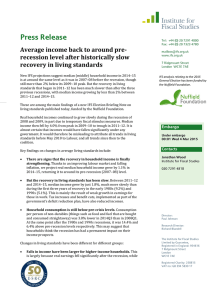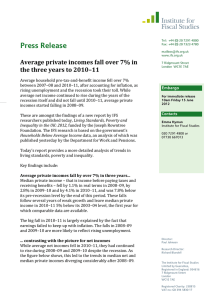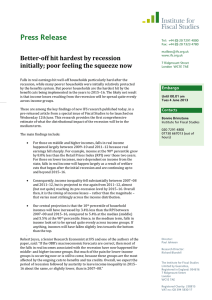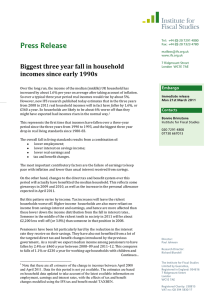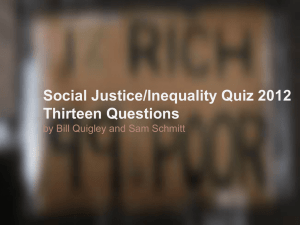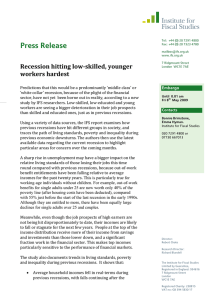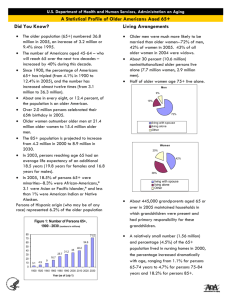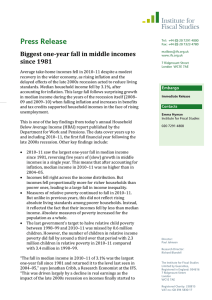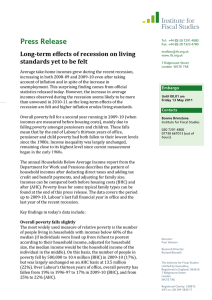Press Release Pay, employment and incomes all fall furthest for young adults
advertisement
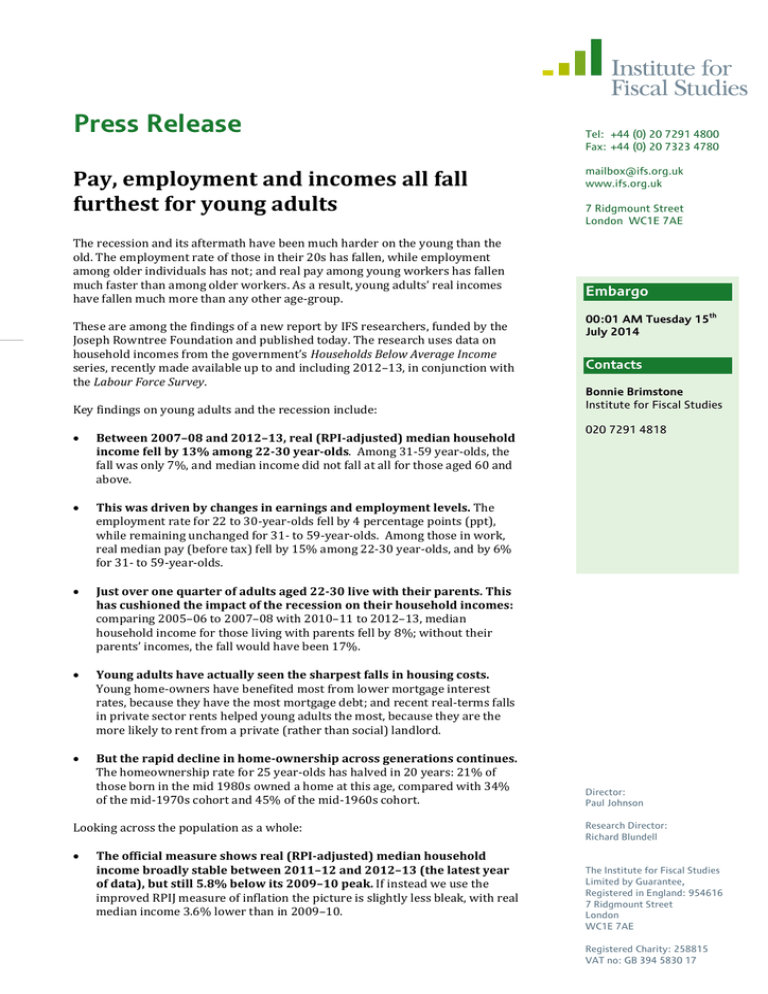
Press Release Pay, employment and incomes all fall furthest for young adults The recession and its aftermath have been much harder on the young than the old. The employment rate of those in their 20s has fallen, while employment among older individuals has not; and real pay among young workers has fallen much faster than among older workers. As a result, young adults’ real incomes have fallen much more than any other age-group. These are among the findings of a new report by IFS researchers, funded by the Joseph Rowntree Foundation and published today. The research uses data on household incomes from the government’s Households Below Average Income series, recently made available up to and including 2012–13, in conjunction with the Labour Force Survey. Key findings on young adults and the recession include: Between 2007–08 and 2012–13, real (RPI-adjusted) median household income fell by 13% among 22-30 year-olds. Among 31-59 year-olds, the fall was only 7%, and median income did not fall at all for those aged 60 and above. This was driven by changes in earnings and employment levels. The employment rate for 22 to 30-year-olds fell by 4 percentage points (ppt), while remaining unchanged for 31- to 59-year-olds. Among those in work, real median pay (before tax) fell by 15% among 22-30 year-olds, and by 6% for 31- to 59-year-olds. Just over one quarter of adults aged 22-30 live with their parents. This has cushioned the impact of the recession on their household incomes: comparing 2005–06 to 2007–08 with 2010–11 to 2012–13, median household income for those living with parents fell by 8%; without their parents’ incomes, the fall would have been 17%. Young adults have actually seen the sharpest falls in housing costs. Young home-owners have benefited most from lower mortgage interest rates, because they have the most mortgage debt; and recent real-terms falls in private sector rents helped young adults the most, because they are the more likely to rent from a private (rather than social) landlord. But the rapid decline in home-ownership across generations continues. The homeownership rate for 25 year-olds has halved in 20 years: 21% of those born in the mid 1980s owned a home at this age, compared with 34% of the mid-1970s cohort and 45% of the mid-1960s cohort. Looking across the population as a whole: The official measure shows real (RPI-adjusted) median household income broadly stable between 2011–12 and 2012–13 (the latest year of data), but still 5.8% below its 2009–10 peak. If instead we use the improved RPIJ measure of inflation the picture is slightly less bleak, with real median income 3.6% lower than in 2009–10. Tel: +44 (0) 20 7291 4800 Fax: +44 (0) 20 7323 4780 mailbox@ifs.org.uk www.ifs.org.uk 7 Ridgmount Street London WC1E 7AE Embargo 00:01 AM Tuesday 15th July 2014 Contacts Bonnie Brimstone Institute for Fiscal Studies 020 7291 4818 Director: Paul Johnson Research Director: Richard Blundell The Institute for Fiscal Studies Limited by Guarantee, Registered in England: 954616 7 Ridgmount Street London WC1E 7AE Registered Charity: 258815 VAT no: GB 394 5830 17 Real income falls since the start of the recession would have been larger were it not for lower housing costs. Between 2007–08 and 2012– 13, average housing costs fell by nearly 20% relative to other prices, pushing down inflation. This was driven by large falls in interest rates: real housing costs for mortgage-paying owner-occupiers fell by 37% - and from 18% to 13% as a fraction of their income. The recession has had differing impacts across the UK. Comparing 2007–08 to 2009–10 with 2010–11 to 2012–13, real falls in median income range from 8% in Northern Ireland to 2% in the East Midlands. After deducting housing costs from income, London saw the joint-biggest falls (with Northern Ireland). There is no clear relationship across the country between pre-crisis income levels and income changes since the crisis (and in particular no clear North-South divide). Incomes have changed differently across the population: Income inequality remained significantly lower than before the recession, though barely changed in 2012–13. The widely-used Gini coefficient measure of inequality was no higher in 2012–13 than in 1990. Median income for non-working households (including pensioners) was 60% of median income for working households in 2007–08, but 67% by 2012–13. This is because workers’ pay fell while benefit entitlements were relatively stable. Two-fifths of the fall in inequality over this period can be attributed to a closing of the gap between households with someone in work and the rest of the population. Inequality fell less if differential changes in housing costs are accounted for, since lower mortgage interest rates primarily benefited higher-income households. On average, real housing costs fell by over 20% for the highestincome half of the population, but by less than 10% for the second and third poorest tenths. Pensioner incomes have continued to grow relative to working-age incomes. When measured after deducting housing costs, median income among pensioner households overtook that of working-age households in 2009–10 for the first time since records began in 1961. By 2012–13, it was 5% higher, having been 5% lower in 2007–08 and 20% lower in 1992. Focusing on those with low living standards: Absolute income poverty rose 600,000 to 14.6 million (23.2%) in 2012– 13: 3.0 million higher than its low point in 2004–05. These figures use the official absolute poverty line (fixed in real terms over time) for incomes measured after deducting housing costs, taking into account smaller-thanaverage falls in housing costs for low-income households. Relative income poverty was broadly unchanged in 2012–13 but remained significantly lower than in 2007–08, using a poverty line of 60% of median income. This was driven by falls for pensioners and families with children – for example, relative poverty among pensioners has fallen by over a quarter since 2007–08, from 17.7% to 13.2%. The official measure of child material deprivation rose by 300,000 children (2.1ppt) in 2012–13, and has generally been on an upwards trajectory since 2007–08. Child material deprivation is highest in London, which also has the highest rate of income poverty (once its higher housing costs are taken into account). The Institute for Fiscal Studies Limited by Guarantee, Registered in England: 954616 7 Ridgmount Street London WC1E 7AE The proportion of individuals in arrears on household bills fell from a peak of 9.9% in 2009–10 to 8.1% in 2012–13. This is despite income levels generally falling over the same period; but the peak in arrears does align with the peak in redundancies. This highlights that arrears may be more related to unexpected income falls than low incomes per se. “Young adults have borne the brunt of the recession” said Jonathan Cribb, a Research Economist at the IFS, and an author of the report. “Pay, employment and incomes have all been hit hardest for those in their 20s. A crucial question is whether this difficult start will do lasting damage to their employment and earnings prospects”. Chris Goulden, Head of Poverty Research at the independent Joseph Rowntree Foundation, said: "This research provides authoritative and robust evidence on recent changes to living standards as households emerge from the economic downturn. Policy-makers should be aware that living standards have fallen for rich and poor with the youngest households faring particularly badly." ENDS Notes to Editors: 1. The full Households Below Average Income publication can be found on the Department for Work and Pensions website at https://www.gov.uk/government/publications/households-below-average-incomehbai-199495-to-201213. 2. Embargoed copies of the full report Living Standards, Poverty and Inequality in the UK: 2014 are available on request. The report will also be available on IFS’s th website from 00:01 AM on Tuesday 15 July 2014. 3. The authors are very grateful for financial support from the Joseph Rowntree Foundation for the project ‘Living Standards, Poverty and Inequality in the UK: 2014’. Co-funding from the ESRC-funded Centre for the Microeconomic Analysis of Public Policy at IFS is also very gratefully acknowledged. 4. Housing costs in the HBAI data include mortgage interest payments, rents, water rates, community water charges, council water charges, structural insurance premiums for owner-occupiers, and ground rents and service charges. Poverty lines for example families in 2012–13, before housing costs (BHC) and after housing costs (AHC): £ per week Childless Single Couple, couple individual one child (age 8) Couple, two children (ages 8 & 15) Lone Lone parent, parent, two one children child (ages 8 & (age 8) 15) Relative AHC £224 £130 £269 £364 £175 £269 Relative BHC £264 £177 £317 £404 £230 £317 Absolute AHC £235 £136 £282 £380 £183 £282 Absolute BHC £272 £182 £326 £416 £237 £326 IFS hosts the ESRC Centre for the Microeconomic Analysis of Public Policy The Institute for Fiscal Studies Limited by Guarantee, Registered in England: 954616 7 Ridgmount Street London WC1E 7AE
